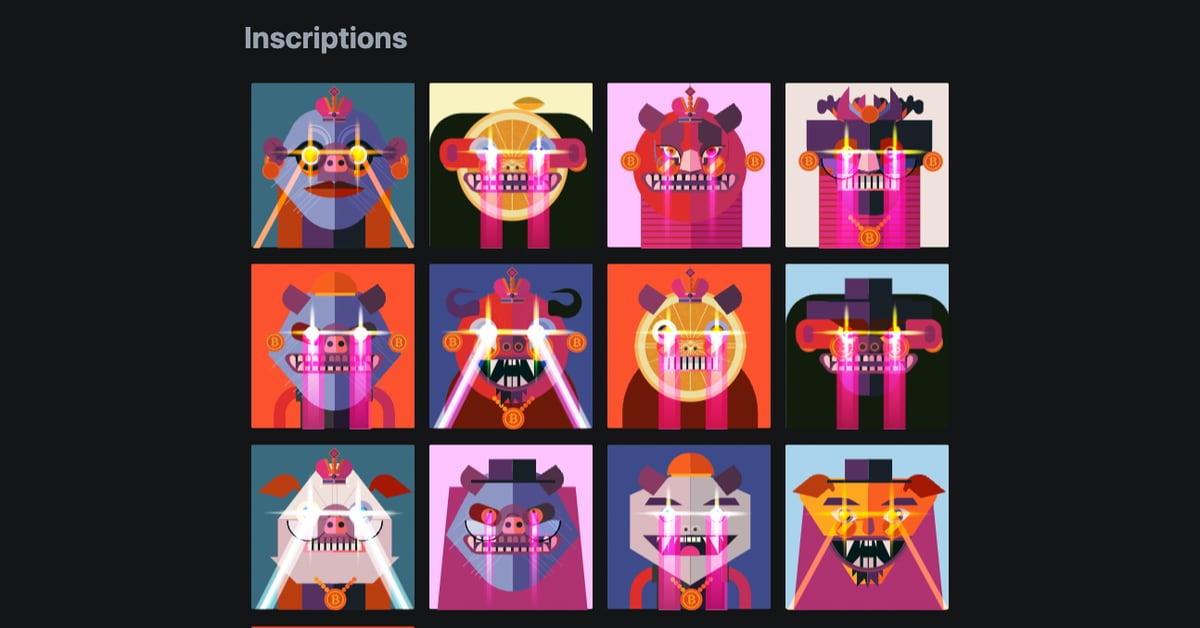
Happy Sunday {{First Name|fellow wayfinder}}!
Last week, we dove into Mongolian and British history to make a case for a future era of “data peace,” which I dubbed Pax BitCoinica.
This week, we look at a rising trend known as “Ordinals,” which I first stumbled upon on Twitter.
Let's dive in.
☕ Reading time: 3 mins
TL;DR
-----
Bitcoin Ordinals (BO) are a rising trend that provides a way to build non-fungible tokens (NFTs) on the Bitcoin (BTC) blockchain, similar to collectible trading cards. Bitcoin Ordinal Theory (BOT) was created by Casey Rodarmor and allows for people to post JPEGs on BTC, which has divided BTC into two camps: BTC Maxis and BTC Ordies. Twetch, a Bitcoin (BSV) social network, has launched a product called Ordinals Wallet to take advantage of the Ordinals craze. The Ordinals craze may force Core Developers to rethink their strategy and increase the BTC block size (even if undesired).What are Ordinals?
Ordinals are like non-fungible tokens (NFTs) on the Bitcoin (BTC) blockchain, similar to collectible trading cards. They have unique numbers, names, and assets attached to them, and some are rarer than others. People collect them for various reasons, including "NFT archaeologists" who study early NFTs.

What is Bitcoin Ordinal Theory?
Bitcoin Ordinal Theory (BOT for short) is the theory behind Ordinals. It was created by Casey Rodarmor, who originally published it on his blog here. In a nutshell, he proposed a way of building NFTs directly on BTC, which didn’t require a “separate token, another blockchain, or any changes to BTC.”
And as you can see, the Ordinal branding is already attracting people to build on top of it. With the above being a BTC version of Ethereum Name Services (ENS).
What are the benefits?
In a nutshell? You can now post your JPEGs (a la NFTs) on BTC.
How does this impact Bitcoin development?
For the last decade, very little development has been taking place on BTC as a result of the block size limit and implementation of SegWit (Segregated Witness) in 2017. The controversial upgrade meant Bitcoin’s protocol was changed to allow for things like Lightning Network and Taproot and kept most development to Bitcoin Core and friends.
As a result, most developers moved over to competing blockchains over the years such as Ethereum, Solana, Polygon, and more.
However, Ordinals would not have been possible on BTC if it weren’t for an exploit (bug) in the Taproot “upgrade.”
What’s interesting about this all is that BTC has now divided into two further camps:
BTC Maxis: “Bitcoin is only for HODLing, so NFTs and JPEGs are spam on the network”
BTC Ordies: “If Bitcoin can do what Ethereum does, let me post my JPEGs”
So right now there is a swarm of “altcoin” developers and NFT artists looking to upload their work to BTC, even though this was an unintentional exploit of Taproot. BTC Maxis are certainly expressing their concerns online:
Is this the first time NFTs have been tried on Bitcoin?
No. Bitcoin SV (BSV) — the project that sought to restore Bitcoin to its original design — has had the ability to do this since day dot.
If anything, BSV proponents showed the world that Bitcoin could always do what every other blockchain claims to do (and then some). But because of politics and personalities, most of the population was either unaware or unwilling to listen.
Now folks in BTC are learning what has already been taught to BSV developers over the years. which may be a good thing in the long run.
Are there any risks to Ordinals?
Plenty. But many of them are not apparent. Some include:
Major lawsuits that may impact BTC Core developers. This may also impact any network effects built up over the years.
Copyright issues for artwork uploaded without permission. Any blockchain is simply a ledger — one designed to be traceable)
Mempool issues. BTC has its block size capped at ~4MB — a legacy of the Segwit upgrade in 2017. As a result, the more NFTs that are forced onto the BTC network, the more issues it will cause for them.
What’s next?
As a result of all the action, the creators of Twetch — a Bitcoin (BSV) social network where you earn in micropayments — have launched a new product called Ordinals Wallet.
They’re well-prepared for the Ordinals craze because they’ve been building with UTXOs on BSV for years, but they have always been a fan of Bitcoin itself (regardless of the ticker symbol).
But BTC’ers may soon learn why some argued for larger block sizes all those years ago:
Because if Bitcoin was always able to do NFTs, why was it limited to only “digital gold” and HODLing? If there is enough demand, this might force Core Developers to rethink their subversion and increase the block size. But may be too big a task and result in a lot more issues for the network.
As for me? My personal strategy remains the same. Stick to first principles and building for the long-term. Pay attention to the blockchain patent wars in the background. And don’t succumb to get-rich-quick schemes or group think.
What are your thoughts on Ordinals? Good, bad, ugly? Would love to hear your thoughts!
Until next week, remember: through patience & persistence, it will come.
George
Last week's premium newsletters:
Daily #193: My Polynesian Tatau (Tattoo)
Daily #194: My Polynesian Tatau (Part 2)
Daily #195: Bing vs. Google (AI Wars)
Daily #196: Trepanation
Daily #197: Using Notion to Organize Bookmarks
❤ Loved this content? Get behind-the-scenes access as I grow my one-person business empire, build more productive communities in the blockchain space, and apply ancient wisdom to modern problems. Click here to upgrade for $10/mo.

